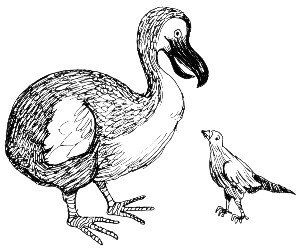STRANGE BUT TRUE- Dodo DNA: Extinct but still cooing

Q. Did stupidity really do-in the dodo bird? –A.E. Newman
A. Too much trust maybe, but why wouldn't it have become trusting on the Galapagos archipelago, where it had had no natural enemies for thousands of years and thus lost its wings, asks Richard Dawkins in The Ancestor's Tale. So when the Portuguese (and later Dutch) sailors arrived on Mauritius in 1507, the abundant dodos were completely tame and defenseless and easily clubbed to death for sport (even though they were deemed "unpalatable"). Other factors too helped bring about their extinction in just a few centuries.
Yet the larger tale here is that something similar has happened to other birds on islands all over the world, to which they fly, settle, then evolve into flightless forms. The heartening sequel to the dodo's story is that scientists who DNA-sampled a few remaining bones determined that dodos were modified pigeons and are nested deep inside the pigeon family tree– closer in fact to some of today's flying pigeons than these are to other flying pigeons!
Q. Are you in love right now? Fair question, but don't you need to know exactly what love is first? –M. Farrell
A. Good luck, because dozens of love definitions have been bandied over the years, says University of California-Santa Barbara sociologist Thomas J. Scheff. Checking an unabridged dictionary, you can find some two dozen meanings, beginning with: 1. A deep, tender, ineffable feeling of affection and solicitude. 2. A feeling of intense desire and attraction... the emotion of sex and romance.
The list, sometimes contradictory, goes on: 3. A pleasurable state, interesting and exciting and joyful, the most important thing in life. 4. A painful affliction, even madness– one set of experiments showed that subjects' condemnation of murder decreased if they were told the motive was jealousy. 5. A disorder because it can lead to sinfulness (church fathers beginning with St. Augustine). 6. A kind of "sickness and craziness, an illusion, a blindness to what the loved person is really like" (Freud). 7. Infatuation, or passionate love, vs fondness, or companionate love (Hatfield and Rapson). 8. Physical closeness leading to physiological "resonance," akin to female roommates' synchronized menstrual cycles. 9. A trance-like state so different from anything else a new term is needed for it– "limerence" (Tennov).
To play on the old song, "I don't know why I love you like I do, nor do I know what I (you) mean by love, but, hey, I'd love to give us a chance to find out."
Q. A rainy-day curiosity: How much does the rain from a thunderstorm weigh? –P. Michaels
A. The density of water is 1000 kilograms per cubic meter (that's 2200 pounds, or 10 percent more than a ton), says Florida State University meteorologist Jon Ahlquist. Thus, each one millimeter of rain over an area of one square kilometer has a mass of a million kilograms, or more than 1,000 tons.
In English units, each 0.1 inch of rain over a square mile weighs 7,200 tons. To relate this to something people can identify, let's go with elephants. According to one online source, a healthy adult African elephant in a zoo weighs four to seven tons, with elephants in the wild weighing substantially less.
"So if we assume five tons for our typical elephant, then it takes roughly 1,400 elephants to make the 7,000 tons, and that is just the weight of 0.1 inch of rain over a square mile, and that's not much of a rainstorm."
Q. You take the distance from the North Pole to the equator, along the meridian through Paris, then divide this distance by 10,000,000 to yield one ten-millionth of the original. That's a pretty exact definition, but not exact enough. So later you redefine it as the distance between two lines marked on a platinum-iridium bar kept at a temperature of 0 degrees C at the International Bureau of Weights and Measures, near Paris. Still not exact enough. So in 1960 you redefine it once again as 1,650,763.73 times the wavelength of the orange-red light emitted by atoms of the gas krypton-86 when an electrical charge is passed through them. Wow! Now what do you have? –B. Franklin
A. The current "meter," fundamental unit of length of the metric system adopted by France in 1795 and used today by most of the world (though not the United States, which goes by the U.S. Customary System), says Beloit College's Paul J. Campbell in For All Practical Purposes: Mathematical Literacy in Today's World. All other units of length, area, and volume are defined in terms of the meter, the kilogram in terms of a platinum-iridium standard.
Send Strange questions to brothers Bill and Rich at [email protected].
#